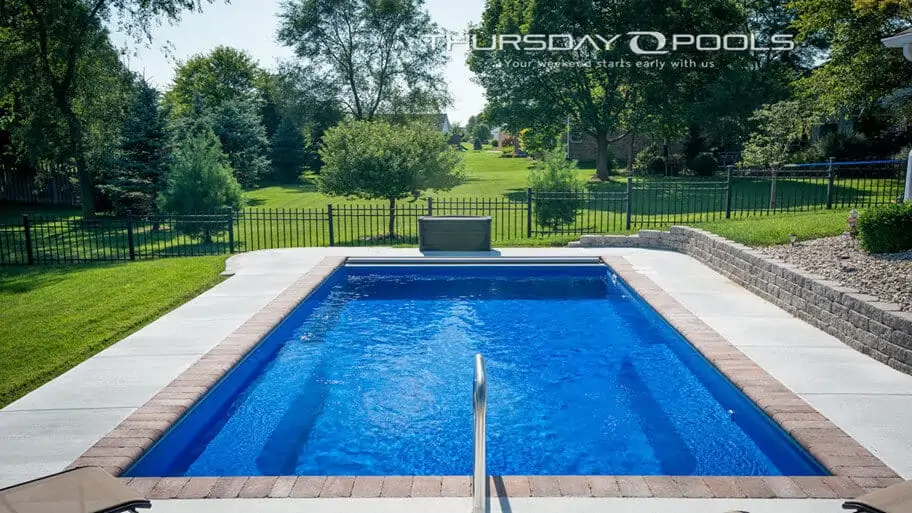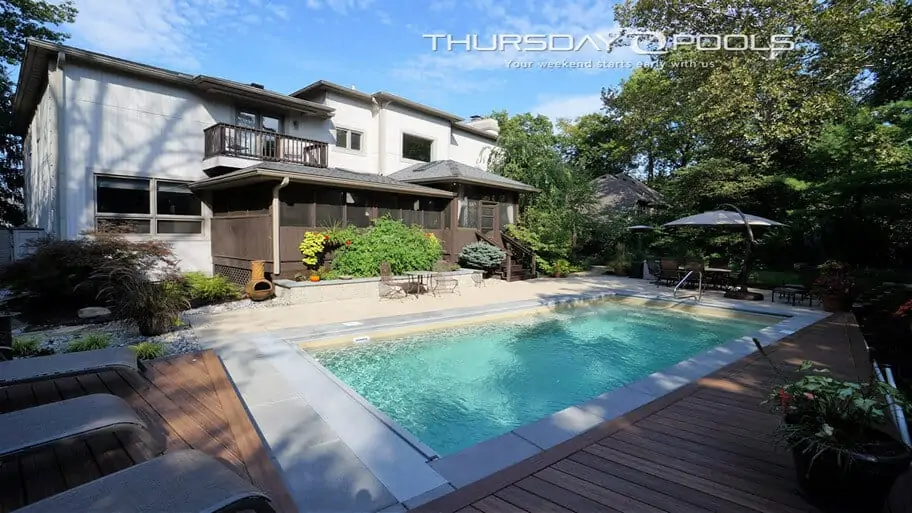We all know that the biggest and most important aspect for pool buyers is the pool itself. It’s the centerpiece of a pool project and what will give you and your family enjoyment for years to come.
However, there’s a lot more to a pool project than just the pool! There’s pool equipment, plumbing, electricity, etc., but what we’re going to focus on in this article is patio options.
The type of patio you choose can be an integral aspect of your pool project as it can truly complete the look of your backyard. And each type of decking brings a different aesthetic. Stamped concrete is different from concrete pavers which are different from standard concrete. Each option has different characteristics, pros, cons, etc., and it’s up to you to find the type of decking that is a perfect fit for your pool project.
So, we’ve put together this article to educate you about each type of concrete decking so you can make an informed final decision on what will bring your vision come to life!
Stamped Concrete Pool Patio
The base material in all of the types of decking we discuss in this article is technically all concrete, but stamped concrete presents a different look and feel LITERALLY!
What is stamped concrete?
Stamped concrete is concrete that goes down in a similar fashion as standard concrete but is finished with an embossed pattern as opposed to a broom finish. In short, once the concrete is down in the frames, finishers throw a dry release agent down on the wet concrete or spray a liquid “release” on the stamping mat itself.
The concrete release is mainly used for releasing the mats from the wet concrete. The second use for release is an opportunity for adding an accent color to make the product look as much like real stone as possible!
Once the release is on the mats get placed in position and then get tamped down on the surface, giving it the name “stamped.” The process of tamping leaves the embossed pattern on the surface and gives the concrete its unique look.
Stamped concrete is known for its high-end look with the goal of making the surface look like real stone, pavers, hardwood, or whatever options the finisher has! There are an abundance of patterns and texture combinations that you can configure with your pool builder if you choose stamped concrete, but there are some important details about the material itself that you need to be aware of.
Cost and Pattern Options
One of the great advantages of stamped concrete is its ability to imitate other decking materials while having the strength of concrete!
Let’s say you really like the look of brick around a pool, but the cost per square foot of brick is out of your budget. That’s where stamped concrete comes in. You see, stamped concrete can imitate the look of other decking options because of the different stamping patterns available.
So, you can use stamped concrete to imitate decking options such as:
- Brick
- Wood
- Travertine
- Flagstone
- Slate
- Cobblestone
- Natural Stone
And, another advantage of stamped concrete—the pricing is cheaper than the natural decking materials listed above at $18-$22 per square foot.
Of course, the price will fall at the higher or lower end based on the stamping pattern that you choose, but the ability to mimic most other decking materials remains unmatched!
Advantages
As we’ve noted, the ability to mimic the look of other decking materials by laying stamping patterns on the concrete and imprinting the design is a huge advantage of stamped concrete.
Another advantage is the variety of colors available to pair with the stamped pattern, which can create numerous combinations. In fact, stamped concrete often consists of two colors:
- A base color that is mixed in the concrete or troweled on the surface
- A release agent that is laid on top of the concrete just before it is stamped
And to protect the stamped concrete, it is sealed to limit damage from pool chemicals and other harmful substances.
Disadvantages
Although it is sealed to limit damage, stamped concrete is concrete, so it will crack eventually. Therefore, it will need to be resealed every 2-3 years.
Now, to provide a bit of an insurance policy for the inevitable cracking, control saw joints are placed in the concrete after installation in specific locations where the concrete contractors think the concrete will need to be. However, it is still possible that the concrete will crack in other areas.
Concrete Pavers
Concrete pavers have a similar appearance to brick and are manufactured similarly to tile as they are created in specific sizes, shapes, and colors.
They are pieced together during the installation process in specific patterns to create the final look and are installed over a base of sand and soil.
Cost and Paver Options
As we noted, concrete pavers come in a variety of shapes and sizes. You can choose from larger or smaller pavers, rectangular or square pavers, and different textures, creating a world of possibilities!
Keep in mind that you will see an increased cost from stamped concrete to concrete pavers at $30-60 per square foot.
Advantages
One significant advantage to concrete pavers is that they will most likely not crack in the future like stamped concrete and standard concrete may. If they do, they are usually warrantied by the manufacturer. It is also rare for them to shift or settle under regular use IF installed properly. But, if a repair is needed underground to solve shifting, settling, or foundational problems, it is simple and easy to complete.
Furthermore, it is easy to add to a patio/decking area consisting of concrete pavers in the future. You can return to your landscaper and request the same concrete pavers so that the continuation remains the same.
Disadvantages
Although it is rare, concrete pavers can settle and shift over time if installed incorrectly. Such issues can be fixed relatively easily, but it is still a disadvantage that comes along with concrete pavers.
Since the foundation laid beneath the concrete pavers is made of compacted stone and earth below it, weeds can grow between the concrete pavers. This can be avoided with polymeric sand which hardens and binds each paver together, creating a barrier between the earth and the pavers. However, this sand will need to be re-applied in the future.
Another disadvantage is that there are not as many color and pattern variations available as there are for stamped concrete. Therefore, you’re more limited in the design of your patio/deck.
Standard Concrete
This is likely the option you’re most familiar with. You’ve seen it in driveways, landscaping around homes, and even pools as well.
Out of the three options discussed in this article, standard concrete is the simplest material used for pool decking.
It’s a standard option in all pool packages, hence the name!
Concrete is poured, smoothed out, and then hardens to create a simple, yet attractive look for your pool project.
Cost
Standard concrete costs $11.50 per square foot, giving it the smallest difference in price range and making it the least expensive option of the three patio options listed in this article.
Advantages
Standard concrete requires the least amount of maintenance when compared to stamped concrete and concrete pavers. Since it isn’t sealed, you won’t have to reseal standard concrete in the future.
It also is not slippery like stamped concrete, so there is a decreased risk of injury for the young ones running around the pool area!
Additionally, standard concrete is not a rough surface, preventing irritation and discomfort to an individual’s feet as they walk around the pool.
Disadvantages
When compared to stamped concrete and concrete pavers, it’s pretty obvious that standard concrete isn’t on the same aesthetic level.
You can get pretty elaborate with patio designs that include stamped concrete and concrete pavers, but standard concrete limits your design options. Most of the time, it will look similar to concrete driveways, making it seem simple. But, if you’re looking for a simpler and more standard look for your pool project, standard concrete could be your best option.
Finally, as you probably guessed, standard concrete can crack in the future which requires you to have it re-finished.
Other Patio Options
We hope that this has given you some more insight into stamped concrete, concrete pavers, and standard concrete. They all have their own unique characteristics that will create a different aesthetic from the others, but none of them make one option “better” than another.
In the end, the final decision lies in your hands to create the dream backyard oasis that you’ve always wanted! And we’re here to educate you so you can make an informed final decision. After all, this investment is a big one!
And don’t forget, you can choose from other patio options as well, including:
- Brick
- Wood
- Travertine
- Flagstone
- Slate
- Cobblestone
- Natural Stone
If you have any further questions, you can send us an email or check out some of our other articles in our Learning Center!








